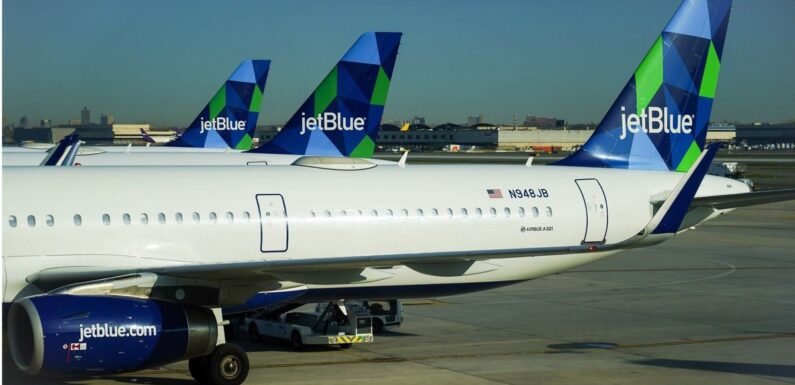
An end to JetBlue and American Airlines’ Northeast Alliance (NEA) likely wouldn’t have an immediate impact on flyers. But the long-term implications of a breakup would depend on whether the airlines decide to enter into a more limited partnership.
The May 19 ruling of federal district judge Leo Sorokin called for American and JetBlue to unwind the alliance within 30 days. In particular, Sorokin objected to the airlines’ joint scheduling and revenue sharing on the large majority of their routes touching Boston and the three major New York-area airports. That must come to halt, Sorokin ordered.
American said Wednesday it would appeal the ruling. But even if it didnt’, summer schedules won’t be impacted, American CFO Devon May said during the Wolfe Research Global Transportation and Industrials Conference in late May.
“If there are adjustments, they’ll be longer term,” he said. “It’s not going to impact customers this summer. Any customers who are booked through the NEA will be taken care of.”
According to the court order, American and JetBlue are not required to pull down the schedules they’ve jointly developed to this point. But because the order requires that they stop sharing revenue, the airlines would want to reposition their competitive posture for a post-NEA world, said Brett Snyder, a travel advisor and airline industry analyst who pens the Cranky Flier blog.
Sorokin said that since the inception of the NEA in early 2021, American has exited more than a dozen routes at LaGuardia that both carriers served before the NEA. Notable among those routes are LaGuardia-Boston and LaGuardia-Orlando.
“In the long run, the inability to share revenue and coordinate means they can’t keep the structure the way they have it,” Snyder said. “American doesn’t even fly from Boston to New York anymore. They let JetBlue have it.”
The fate of slot leases in New York
A major factor is the slots they have leased to each other at capacity-constrained LaGuardia and JFK as part of the alliance. According to the Sorokin opinion, American has leased 69 daily arrival and departure slots to JetBlue at LaGuardia and 30 slots at JFK. JetBlue has leased eight slots at JFK to American.
Snyder said American could continue its slot leases to JetBlue. But if American, absent the NEA, wants to make a run at the New York-area primacy of Delta and United, it would have to retake those slots and invest heavily.
That challenging proposition is one reason that analyst Savi Syth of Raymond James wrote in an investment note that the impact of an NEA breakup would be “very negative” for American.
“While American will likely regain its slots leased to JetBlue, it will now have to rebuild JFK and LGA at likely lower profitability given its reliance on regional jets and with the lack of feed from JetBlue,” Syth wrote.
The fare impact of unwinding the NEA would likely differ by route. But on the whole, airfares could go down in the period shortly after an end to the alliance, said Brad Beakley, CEO of the travel industry consultancy Hospitio.
“My opinion is that what they’re doing allows them more pricing power,” he said. “In theory, it allows JetBlue to price closer to American. Potentially, we’ll see downward pricing pressure if there are more competitors.”
A reciprocal loyalty program could survive
For members of the American AAdvantage and JetBlue TrueBlue loyalty programs, the end of the NEA wouldn’t necessarily be problematic. The carriers could decide to continue to offer reciprocal frequent flyer accruals and redemptions. Indeed, over the past two years the two airlines have realigned their methods for obtaining loyalty status to more or less mirror one another.
Still, if the NEA ends, the two carriers might want to roll back at least some of their reciprocal benefits, such as giving upgrades to status members no matter which carrier they are flying.
In his ruling, Sorokin wrote that it would be legal for an American-JetBlue partnership to mimic the partnership American struck with Alaska Airlines in 2020.
Under that arrangement, American customers get access to domestic Alaska routes via codeshare, while Alaska patrons gain access to American’s international operations from the West Coast. The partnership also offers reciprocal loyalty benefits, including lounge access. It includes revenue sharing, but on a much more limited basis than the NEA.
May was noncommittal when asked at the Wolfe Research conference whether American would be interested in mimicking the Alaska partnership with JetBlue.
“There’s some value in an Alaska-style agreement,” he said. “We like the NEA and how it’s structured. We believe it is delivering for our customers.”
Source: Read Full Article









